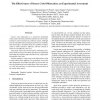IH
2005
Springer
13 years 9 months ago
2005
Springer
Software protection is an area of active research in which a variety of techniques have been developed to address the issue. Examples of such techniques are software watermarking, ...
WCRE
2005
IEEE
13 years 10 months ago
2005
IEEE
In recent years, code obfuscation has attracted attention as a low cost approach to improving software security by making it difficult for attackers to understand the inner worki...
ACSC
2006
IEEE
13 years 10 months ago
2006
IEEE
Code obfuscation is a relatively new technique of software protection and it works by deterring reverse engineering attempts by malicious users of software. The objective of obfus...
ACSAC
2008
IEEE
13 years 10 months ago
2008
IEEE
We propose STILL, a generic defense based on Static Taint and InitiaLization anaLyses, to detect exploit code embedded in data streams/requests targeting at various Internet servi...
IWPC
2009
IEEE
13 years 11 months ago
2009
IEEE
Source code obfuscation is a protection mechanism widely used to limit the possibility of malicious reverse engineering or attack activities on a software system. Although several...

